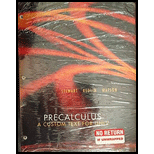
To calculate: The equation of a circle whose end points of diameter are
Answer to Problem 98E
The equation of the circle is
Explanation of Solution
Given information:
The end points of diameter of the circle are
Formula used:
The standard form of the equation of the circle is
Distance
Midpoint of the segment that joins two points
Calculation:
Consider the provided conditions that end points of diameter of the circle are
Now, the center of the circle is the midpoint of the diameter.
Recall that the midpoint of the segment that joins two points
Evaluate the midpoint of the segment that joins
Therefore, coordinates of center are
Now, the radius of the circle is distance between the center of the circle and any one end point of diameter.
Recall that the distance
Evaluate the distance between
Therefore, radius of circle is
Recall that the standard form of the equation of the circle is
Compare,
Here,
Substitute the values in standard equation of circle,
Thus, the equation of circle is
Chapter 1 Solutions
Precalculus - A Custom Text for UNLV
- 5. Submit answer Practice similar X Compute T2(x) at x = 0.6 for y = e and use a calculator to compute the error le-T2(x)| at x = 0.2. T2(x) \e - T₂(x) = Submit answer Answers Answer II 0 @ T E R 5 do The Weather Channel DELL F7 FB D F G H UP Score 8 B N Marrow_forwardASAP 1arrow_forward4. Su Write out the first four terms of the Maclaurin series of f(x) if f(0) = -9, f'(0) = 4, f"(0) = -12, f""(0) = 5 f(x) = +... Submit answer Next item Answers Attempt 7 of 7 Answer ][ 0 T The Weather Channel DELL UP P Score F4 F5 F6 F7 F8 % A 5 6 &arrow_forward
- H.W Ex find the solution by using Bernoulli method of D.E? dy/dx4y = xy³/2arrow_forwardby series find the Solution U (x) = x²- X³+ x²+'S (1+x+) u(t) st 0 (2) u(x) = x's (6x-2+) u(t) St U (x) = x + 2 {xt 41t) dt u(x)=x+2arrow_forwardConsider the Boundary-Initial Value problem J²u и ди 4 0 0 მე2 It u(0,t) = 0, 0, u(6,t) = 0, t>0 u(x, 0) = x(6x), 0 < x <6 This models a heated wire, with zero endpoints temperatures. The solution u(x,t) of the initial-boundary value problem is given by the series u(x,t)-b, sin П3 n=1 (b, sin ((2n − 1) — x) e-cnt where bn ☐ and Сп ☐arrow_forward
- • -7 10 1.0 (2 - x) for 0 < x < 2, Let f(x) = for 2< x < 6. Compute the Fourier cosine coefficients for f(x). Ao An Give values for the Fourier cosine series C(x) = = Ao • C(6) = = C(-1) = = C(11) = + n=1 IM 8 An cos пп (π x ). 6arrow_forwardThe Fourier series of the function is given by where со Сп and bn || f(x) = {- 9x if π < x < 0 -4x if 0 < x < π f(x) ~ CO n=0 (Cn cos ((2n+1) x) - Σ bn sin (nx) n=1arrow_forwardConsider the Boundary-Initial Value problem a²u J²u 9 მე2 Ət²' , 0 0 u(0,t) = 0, u(5,t) = 0, ди u(x, 0) = x(5 − x), at t>0 (x, 0) = 0, 0 < x < 5 This models the displacement u(x,t) of a freely vibrating string, with fixed ends, initial profile x (5 - x), and zero initial velocity. The solution u(x, t), is given by the series ∞ 4 u(x, t) = n=1 bɲ sin (· П (n = 7 x ) cos(cnt) where ཆུ་ང་ and Сп =arrow_forward
- The Fourier sine series of the function is given by 3x f(x) = = if 0x5/3 5 if 5/3 x < 5 where bn b₁ = ☐ ∞ ƒ(2) ~ Σb, sin (n = 2) n=1 (품)arrow_forwardFind the values of a and b for which each function will be differentiable for all values of x on its domain. Note: Please write the answer in the form of ordered pairs (a, b). a² f(x) = x -2b, x ≤-1 b²x,x > −1 2ax²+62arrow_forwardk. 1. |_ 1/2 S 0 cos(x-2) x3 √1+ e¯x ex dx dxarrow_forward
 Calculus: Early TranscendentalsCalculusISBN:9781285741550Author:James StewartPublisher:Cengage Learning
Calculus: Early TranscendentalsCalculusISBN:9781285741550Author:James StewartPublisher:Cengage Learning Thomas' Calculus (14th Edition)CalculusISBN:9780134438986Author:Joel R. Hass, Christopher E. Heil, Maurice D. WeirPublisher:PEARSON
Thomas' Calculus (14th Edition)CalculusISBN:9780134438986Author:Joel R. Hass, Christopher E. Heil, Maurice D. WeirPublisher:PEARSON Calculus: Early Transcendentals (3rd Edition)CalculusISBN:9780134763644Author:William L. Briggs, Lyle Cochran, Bernard Gillett, Eric SchulzPublisher:PEARSON
Calculus: Early Transcendentals (3rd Edition)CalculusISBN:9780134763644Author:William L. Briggs, Lyle Cochran, Bernard Gillett, Eric SchulzPublisher:PEARSON Calculus: Early TranscendentalsCalculusISBN:9781319050740Author:Jon Rogawski, Colin Adams, Robert FranzosaPublisher:W. H. Freeman
Calculus: Early TranscendentalsCalculusISBN:9781319050740Author:Jon Rogawski, Colin Adams, Robert FranzosaPublisher:W. H. Freeman
 Calculus: Early Transcendental FunctionsCalculusISBN:9781337552516Author:Ron Larson, Bruce H. EdwardsPublisher:Cengage Learning
Calculus: Early Transcendental FunctionsCalculusISBN:9781337552516Author:Ron Larson, Bruce H. EdwardsPublisher:Cengage Learning





